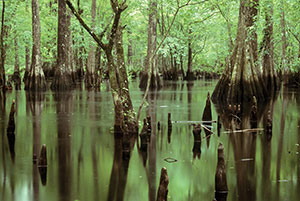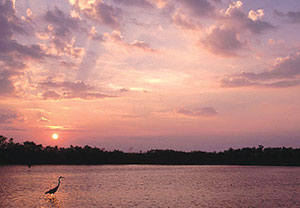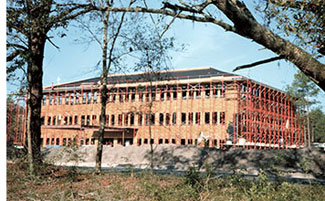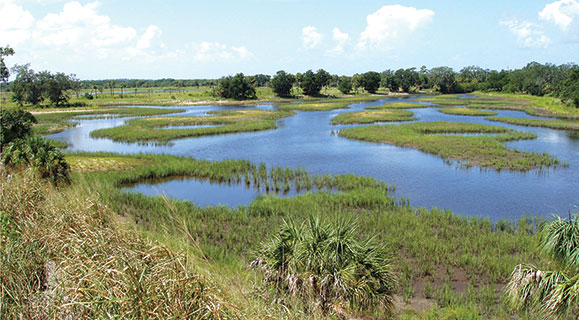Cockroach Bay is located in Tampa Bay, the District’s highest priority SWIM water body, and is one of the largest, most complex ecosystem restoration projects ever developed for the Tampa Bay estuarine ecosystem.
The 1980s was a decade of added responsibility for the District. A number of environmental programs were created by the Legislature during these years and, as a result, staff realigned priorities to accomplish multiple significant undertakings.
Save Our Rivers
The decade began with the creation of a statewide program in 1981 that helped guide the District’s future land management activities. The Water Management Lands Trust Fund, commonly referred to as the “Save Our Rivers” program, allowed the District to acquire lands for the purposes of water management, supply and protection. Prior to this program, the District focused mainly on the flood control benefits of lands.
District staff began to evaluate potential land purchases for a number of important factors, including the preservation and/or restoration of natural systems, water quality enhancement, structural flood control, recharge potential, potable water supply, water conveyance, natural flood control and recreation. Through the Save Our Rivers program, the District was able to acquire approximately 112,600 acres in fee simple and 6,266 acres of less-than-fee lands. Fee simple is the purchase of lands outright. Less-than-fee is the purchase of limited property rights, allowing the District to acquire only the right to conserve and protect resources on a property, while still keeping the land under private ownership.

Through the Save Our Rivers program, the District acquired Green Swamp West to assist in protecting the region’s water resources.
The first major land acquisition using Save Our Rivers funding was the Green Swamp West property. The protection of this vital river corridor has been essential to the District’s water management activities over the years. The land’s ability to slow the flow of floodwaters, sustain rivers and streams, and store surface water makes it a valuable acquisition of the Save Our Rivers program.
This program was one of many handed to the state’s water management districts during the decade. “It was a compliment to the District that our Legislature had the confidence to give us so many programs,” said Gary Kuhl, the District’s executive director from 1983 to 1988. “Our staff saw the logic behind these initiatives and worked hard to get everything implemented in a timely manner while being good stewards of taxpayer dollars.”
Water Quality Act
The District’s mission to protect water quality was strengthened in 1983 with the passing of the state’s Water Quality Assurance Act. This act came shortly after the Task Force on Water Issues reported that the threat of groundwater and surface water contamination had become a major problem. To combat this situation, the act established a fund for cleaning up pollution. As a result, one task passed on to the water management districts was the mandatory plugging of all known abandoned artesian wells.
This new responsibility had a major impact on the water quality of our state. Before this act, abandoned artesian wells could be left unplugged. In that condition, the wells became a source of water contamination by allowing poor quality water from lower aquifers to invade the drinking water of the Upper Floridan aquifer. The mandatory plugging of these wells led to cleaner drinking water for District residents.
Wetlands Protection Act
The next year, as a result of an increasing loss of wetlands, the state passed the Warren S. Henderson Wetlands Protection Act of 1984. This legislation addressed the decrease in and damage to Florida’s wetlands due to construction, forestry, mining, drainage and other previously unregulated activities. The act formally recognized the value that these wetlands have in protecting water quality and preserving the state’s natural habitat.
As a result of the Henderson Act, District staff began to regulate activities that impact our wetlands. The protection required by this act eventually helped to develop the District’s current Environmental Resource Permitting program.
“At the time, we were just beginning to realize the importance of these small wetlands to birds and other wildlife,” said Kuhl.

Sarasota Bay is one of the District’s 10 SWIM priority water bodies.
SWIM Program
In 1987, the District’s role in preserving natural systems was enhanced when the Florida Legislature passed the Surface Water Improvement and Management (SWIM) Act to protect, restore and maintain Florida’s highly threatened surface water bodies. Under this act, the state’s five water management districts identified a list of priority water bodies within their authority and implemented plans to improve them.
SWIM projects restore degraded or destroyed natural systems, enhance existing habitats and promote the preservation of natural habitats. There are currently 10 priority water bodies protected by the District’s program, which has restored more than 6,000 acres of freshwater, estuarine and upland habitat since 1987. In addition, SWIM projects have provided water quality treatment to more than 50,000 acres of watershed.
When looking back, Kuhl is proud of the progress made by staff during his tenure.
“We recognized a number of environmental challenges and brought them to the table for discussion,” said Kuhl. “Our ability to manage all of the programs handed to us by the Legislature was a great accomplishment. During the 1980s, the District changed from a small local agency to the beginning of a major positive player in water management.”
District Changes
In addition to programmatic changes, the District underwent some significant structural changes in the 1980s. During this time, 16 permanent and mobile buildings were added to the Brooksville Headquarters, including Buildings 3 and 6. In 1987, the District also opened the current Bartow Service Office to serve local residents.

Construction on Brooksville’s Building 4 began in 1989.

